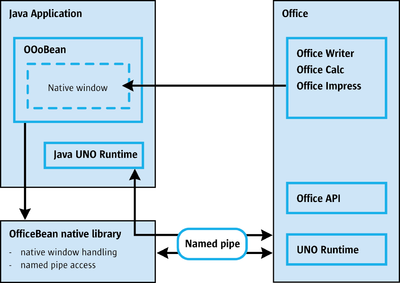Difference between revisions of "Documentation/DevGuide/JavaBean/Configuring the Office Bean"
OOoWikiBot (Talk | contribs) m (Robot: Changing Category:Documentation/Developers Guide/JavaBean for Office Components) |
OOoWikiBot (Talk | contribs) m (FINAL VERSION FOR L10N) |
||
| Line 5: | Line 5: | ||
|NextPage=Documentation/DevGuide/JavaBean/Default Configuration | |NextPage=Documentation/DevGuide/JavaBean/Default Configuration | ||
}} | }} | ||
| − | {{DISPLAYTITLE:Configuring the Office Bean}} | + | {{Documentation/DevGuideLanguages|Documentation/DevGuide/JavaBean/{{SUBPAGENAME}}}} |
| + | {{DISPLAYTITLE:Configuring the Office Bean}} | ||
[[Image:process.png|none|thumb|400px|The OfficeBean]] | [[Image:process.png|none|thumb|400px|The OfficeBean]] | ||
Revision as of 13:12, 15 May 2009
The fundamental framework of the Office Bean is contained in the officebean.jar archive file that depends on a local library officebean.dll or libofficebean.so, depending on the platform. The interaction between the backend OpenOffice.org process, officebean local library, Office Bean and the Java environment is shown in the illustration below.
The Office Bean allows the developer to connect to and communicate with the OpenOffice.org process through a named pipe. It also starts up a OpenOffice.org instance if it cannot connect to a running office. This is implemented in the Office Bean local library. The Office Bean depends on three configuration settings to make this work. It has to find the local library, needs the location of the OpenOffice.org executable, and the bean and office must know the pipe name to use.
| Content on this page is licensed under the Public Documentation License (PDL). |
